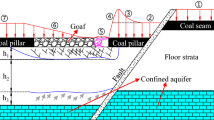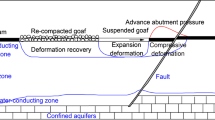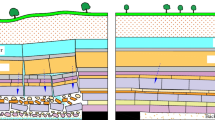Abstract
Floor heave and water inrush accidents are likely in fault-traversing roadways above highly confined aquifers. In this paper, the deflection curve equation for the key floor stratum of a fault-traversing roadway in the Zhaogu no. 2 coal mine was derived based on the cantilever beam model, and the line strain in the failure zone, ε, was introduced to characterize the relationship between floor heave and deformation of deep intact rock layers. Then, three- dimensional pre-grouting technology was established for floor reinforcement. Analysis indicated that the rock surrounding the fault-traversing roadway was highly fractured, increasing the risk of water hazards. Numerical UDEC simulations showed that the plastic zone of the roadway was greater due to the faults; the floor heave, in this case, was 2.6 times greater than without faults. However, water pressure applied to the floor had a limited impact on deformation of the surrounding rock. The measured maximum deflection of the stratum was 644 mm, and the line strain ε in the failure zone in the floor was 67 mm, which resulted in a difference of 3.5% compared with the modelled results. The apparent resistivity in the grouted areas, observed through comprehensive geophysical explorations, was increased, suggesting that the grouting reinforcement had been successful.
Zusammenfassung
Unfälle durch Sohlhebung und Wassereinbruch sind nicht unwahrscheinlich bei Fahrbahnen, die Verwerfungen über stark gespannten Grundwasserleitern queren. In dieser Arbeit wurde die Gleichung der Verformungskurve für die Hauptbodenschicht einer störungsüberquerenden Fahrbahn in der Zhaogu-Nr. 2 Kohlemine abgeleitet auf der Grundlage des Kragträger-Modells. Die Linienbelastung in der Bruchzone ε wurde eingeführt, um die Beziehung zwischen der Sohlhebung und der Verformung tiefer intakter Gesteinsschichten zu beschreiben. Anschließend wurde eine dreidimensionale Vorverpressungstechnologie zur Bodenverstärkung eingeführt. Die Analyse ergab, dass das Gestein, das die störungsüberquerende Straße umgab, stark gebrochen war, was das Gefahrenrisiko von Wassereinbrüchen erhöhte. Numerische UDEC-Simulationen zeigten, dass die plastische Zone der Fahrbahn aufgrund der Verwerfungen größer war. Die Sohlhebung war in diesem Fall 2,6-mal größer als ohne Verwerfungen. Der auf den Boden ausgeübte Wasserdruck hatte jedoch einen begrenzten Einfluss auf die Verformung des umgebenden Gesteins. Die gemessene maximale Biegung der Schicht betrug 644 mm, und die Linienverformung ε in der Bruchzone im Boden betrug 67 mm, was zu einer Differenz von 3,5 % im Vergleich zu den modellierten Ergebnissen führte. Der scheinbare spezifische Widerstand in den abgedichteten Bereichen, der durch umfassende geophysikalische Untersuchungen beobachtet wurde, erhöhte sich, was darauf hindeutet, dass die Verpressungsverstärkung erfolgreich gewesen war.
Resumen
Los accidentes por levantamiento del piso y de irrupción de agua son altamente probables en rutas que atraviesan fallas sobre acuíferos altamente confinados. En este artículo, la ecuación de la curva de desviación para el estrato clave del piso de una ruta que atraviesa fallas en la mina de carbón n° 2 en Zhaogu, se obtuvo en base al modelo de viga en voladizo; se introdujo la tensión de línea en la zona de falla, ε, para caracterizar la relación entre el levantamiento del piso y la deformación de las capas de roca intactas profundas. Luego, se estableció la tecnología tridimensional de pre-lechada para el refuerzo del piso. El análisis indicó que la roca que rodeaba la ruta estaba muy fracturada, lo que aumentaba el riesgo de peligros hídricos. Las simulaciones numéricas de UDEC mostraron que la zona plástica de la carretera era mayor debido a las fallas; la elevación del piso, en este caso, fue 2,6 veces mayor que sin fallas. Sin embargo, la presión del agua aplicada al piso tuvo un impacto limitado en la deformación de la roca circundante. La desviación máxima medida del estrato fue de 644 mm, y la tensión de línea ε en la zona de falla en el piso fue de 67 mm, lo que resultó en una diferencia de 3,5% en comparación con los resultados modelados. La aparente resistividad en las áreas con lechada, observada a través de exploraciones geofísicas exhaustivas, aumentó, lo que sugiere que el refuerzo de la lechada había sido exitoso.
抽象
底鼓和突水事故可能发生于高承压含水层上断层穿越的巷道。基于悬臂梁模型,推导出赵固2号矿断层穿越巷道底板关键层的挠度曲线方程,引入破坏区的线应变(ε)来表征深部完整岩体的底鼓与变形关系。然后,建立了三维预注浆底板加固技术。分析显示,被断层穿越巷道的围岩高度破裂,突水风险增大。UDEC数值模拟表明,由于断层影响,巷道塑性区增大,底鼓量比没有断层时大2.6倍。施加于底板上的水压作用对围岩变形影响有限。实际测得地层最大挠曲644毫米,破坏区底板线应变(ε)67毫米,实测结果与模拟结果差异3.5%。综合地球物理勘探也显示,灌浆区视电阻率提高,灌浆加固效果显著。









Similar content being viewed by others
References
Bai JB, Li WF, Wang XY, Xu Y, Huo LJ (2011) Mechanism of floor heave and control technology of roadway induced by mining. J Min Saf Eng 28(1):1–5
Cheng Y, Bai JB, Yan S, Xu Y, Wang XY, Ma SQ (2012) Control mechanism and technique of floor heave with reinforcing solid coal side. Int J Rock Mech Min Sci 37(22):841–845
Gao MZ (2008) Mechanism of roadway floor heave by bending under pressure and its control. J Anhui Univ Sci Technol 28(1):20–24
Gao YB, Liu D, Zhang X, He M (2017) Analysis and optimization of entry stability in underground longwall mining. Sustainability 9:2079
Guo BH, Lu TK (2008) Analysis of floor heave mechanism and cutting control technique in deep mines. J Min Saf Eng 25:91–94 (In Chinese)
Guo ZP, Du ZW, Hu SC, Zhang XF, Wang K, Guo JX (2017) Comprehensive treatment methods of floor heave disasters in mining areas of China. Geotech Geol Eng 35(5):2485–2495
Jiao YY, Wang L, Song XZ, Amoussou CA (2013) Improvement of the U-shaped steel sets for supporting the roadways in the loose thick coal seam. Int J Rock Mech Min Sci 60:19–25
Li CY, Zhang Y, Zhang GJ, Gao SY, Wang HB (2018a) Crack propagation mechanisms and stress evolution of floor under dynamic disturbance in deep coal mining. Chin J Geotech 40(11):2031–2040 (in Chinese)
Li YG, Ma NJ, Ma J (2018b) Surrounding rock’s failure characteristic and rational location of floor gas drain-age roadway above deep confined water. J China Coal Soc 43(9):2491–2500
Masaru A, Satoru K (2012) Novel grout material comprised of calcium phosphate compounds: in vitro evaluation of crystal precipitation and strength reinforcement. Eng Geol 125:119–128
Qian D, Zhang N, Pan D, Xie Z, Shimada H, Wang Y, Zhang C, Zhang N (2017) Stability of deep underground openings through large fault zones in argillaceous rock. Sustainability 9(11):28–56
Tan XJ, Chen WZ, Liu HY, Chan AH, Tian HM, Meng XJ, Wang FQ, Deng XL (2017) A combined supporting system based on foamed concrete and U-shaped steel for underground coal mine roadways undergoing large deformations. Tunnel Undergr Space Technol 68:196–210
Wang C, Wang Y, Lu S (2000) Deformational behavior of roadways in soft rocks in underground coal mines and principles for stability control. Int J Rock Mech Min Sci 37:937–946
Wang Q, Qin Q, Jiang B, Yu HC, Pan R, Li SC (2019) Study and engineering application on the bolt-grouting reinforcement effect in underground engineering with the fractured surrounding rock. Tunnel Undergr Space Technol 84:237–247
Widmann R (1996) International society for rock mechanics commission on rock grouting. Int J Rock Mech Min Sci 33:803–847
Xu YC, Li JB (2014) “Pore-fractured lifting type” mechanical model for floor water inrush of the grouting enforcement working face. J China Univ Min Technol 43(1):49–55 (in Chinese)
Xu YC, Chen XM, Li JB, Yao YL (2013) Experimental research on floor heave and water inrush in the broken rock roadway under great depth and high water pressure. J China Coal Soc 38(1):124–127
Xu YC, Xie XF, Liu SQ (2017) Quantitative determination of mechanical property of “enhance-damage” for floor rock mass in grouting reinforcement working face. J Min Saf Eng 34(06):1186–1193 (in Chinese)
Zhang JP, Liu LM, Li QH, Peng W, Zhang FT, Cao JZ, Wang H (2019) Development of cement-based self-stress composite grouting material for reinforcing rock mass and engineering application. Constr Build Mater 201:314–327
Zhong Z, Tu Y, Liu X (2012) Occurrence mechanism and control technology of the floor heave disaster for the soft-rock tunnel. Disaster Adv 5:987–992
Zong YJ, Han LJ, Han GL (2013) Mechanical characteristics of confined grouting reinforcement for cracked rock mass. J Min Saf Eng 30(4):483–488
Acknowledgements
This study was funded by National Natural Science Foundation of China (CN) (Grant number 2013CB227903).
Author information
Authors and Affiliations
Corresponding author
Electronic supplementary material
Below is the link to the electronic supplementary material.
Rights and permissions
About this article
Cite this article
Xu, Y., Zhang, E., Luo, Y. et al. Mechanism of Water Inrush and Controlling Techniques for Fault-Traversing Roadways with Floor Heave Above Highly Confined Aquifers. Mine Water Environ 39, 320–330 (2020). https://doi.org/10.1007/s10230-020-00670-1
Received:
Accepted:
Published:
Issue Date:
DOI: https://doi.org/10.1007/s10230-020-00670-1




